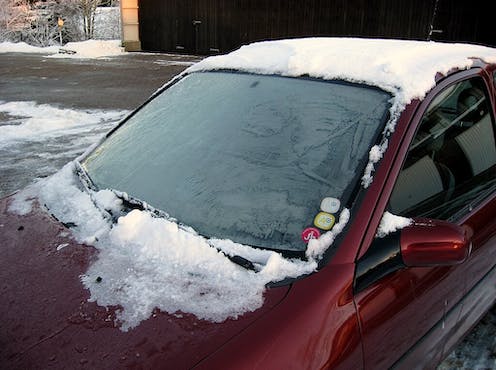Condensation and cold combine to create that layer of ice on car windshields in winter. Tomasz Sienicki/Wikimedia Commons, CC BY-SA
If you live somewhere that gets cold in the winter, you’ve probably seen cars parked outdoors covered in a thin layer of ice on a chilly morning. But what causes this frost, and how can you get rid of it quickly?
I’m a mechanical engineering professor who studies how water vapor interacts with airborne particles under different atmospheric conditions. Frosty windshields are similar to some of the thermodynamic questions I study in the lab, and they’re also a pesky issue that I deal with every winter on my way to work.
Windshield condensation
The air in Earth’s atmosphere always contains a certain amount of water vapor, but there’s only so much water vapor the air can hold. Scientists call that limit 100% relative humidity. The dew point refers to the temperature at which relative humidity reaches 100%.
Wet air has high dew point temperature, while dry air has a low dew point temperature. With each degree drop in temperature, the air gets closer to its dew point temperature – or its water vapor carrying capacity. Any cooling after the dew point temperature has been reached causes water to condense onto surfaces, or form into fog.
Overnight, car windshields facing the cold dark sky are radiatively cooled, meaning they release heat out into their surrounding area in the form of visible and invisible light. As air comes in contact with the cold windshield, it can reach its dew point temperature. Then, the water vapor condenses onto the windshield.
When this radiative cooling drops the temperature on the windshield’s surface to below the freezing point, 32 degrees Fahrenheit (zero degrees Celsius), the layer of condensed water on the windshield turns to frost.
Defrosting your car
To defrost an icy windshield, you can follow a few different approaches, some of which take longer and require more effort than others.
One option is to directly spray a small amount of warm liquid on the layer of frost to help melt it. For this approach to work, the spray liquid must be hot enough to raise the overall temperature of the frost layer to above the melting point. But the temperature can’t be way hotter than the temperature of the glass or you’ll crack your windshield.
A better way to melt the ice without damaging your car is to spray your windows with a warm liquid that has a lower freezing point than water, like a mixture of rubbing alcohol and water. This warm mixture will melt the frost layer without heating up the glass, and the resulting liquid layer on the windshield will have a lower freezing point than water. It will remain liquid, and you can wipe it away with your windshield wipers.
Similar alcohol and water mixtures – glycol, for example – are commonly used to maintain the icy surface of skating rinks.
A mix of water and rubbing alcohol can melt ice on your windshield.
This approach can melt the ice reasonably quickly and easily, without too much effort. You don’t even have to turn on your car.
If you have a little more time, you can start the car and run the air defrost system to blow hot air – aim for above 80 degrees Fahrenheit – onto the inside of the windshield. This warms the windshield and will eventually melt the frost layer. Once you see some melting, you can use the windshield wipers to wipe the rest of the ice away.
This option consumes more energy, as your car will have to heat up the windshield, but it doesn’t require you to do much.
Using the defrost system to blow warm air toward the windshield will also help to clear the inside of the windshield when it gets fogged up from condensation. Otherwise, if it’s dry outside, you can also clear up windshield fog by opening the car window and letting in outside air.
You can use an ice scraper to break the ice on your windshield into chunks, so your wiper blades can clean them off.
AP Photo/David Zalubowski
If you are in a hurry or need some exercise, you can use an ice scraper to break up frost on your windshield, creating smaller islands of ice. The windshield wiper can then mechanically dislodge the chunks by moving them around and melting them. This requires more energy on your part, but it doesn’t require much from your car.
If you have a relaxed start to your day, you can let the Sun warm the windshield and slowly melt the frost layer for you. This technique saves energy in every way imaginable.
Suresh Dhaniyala does not work for, consult, own shares in or receive funding from any company or organization that would benefit from this article, and has disclosed no relevant affiliations beyond their academic appointment.













